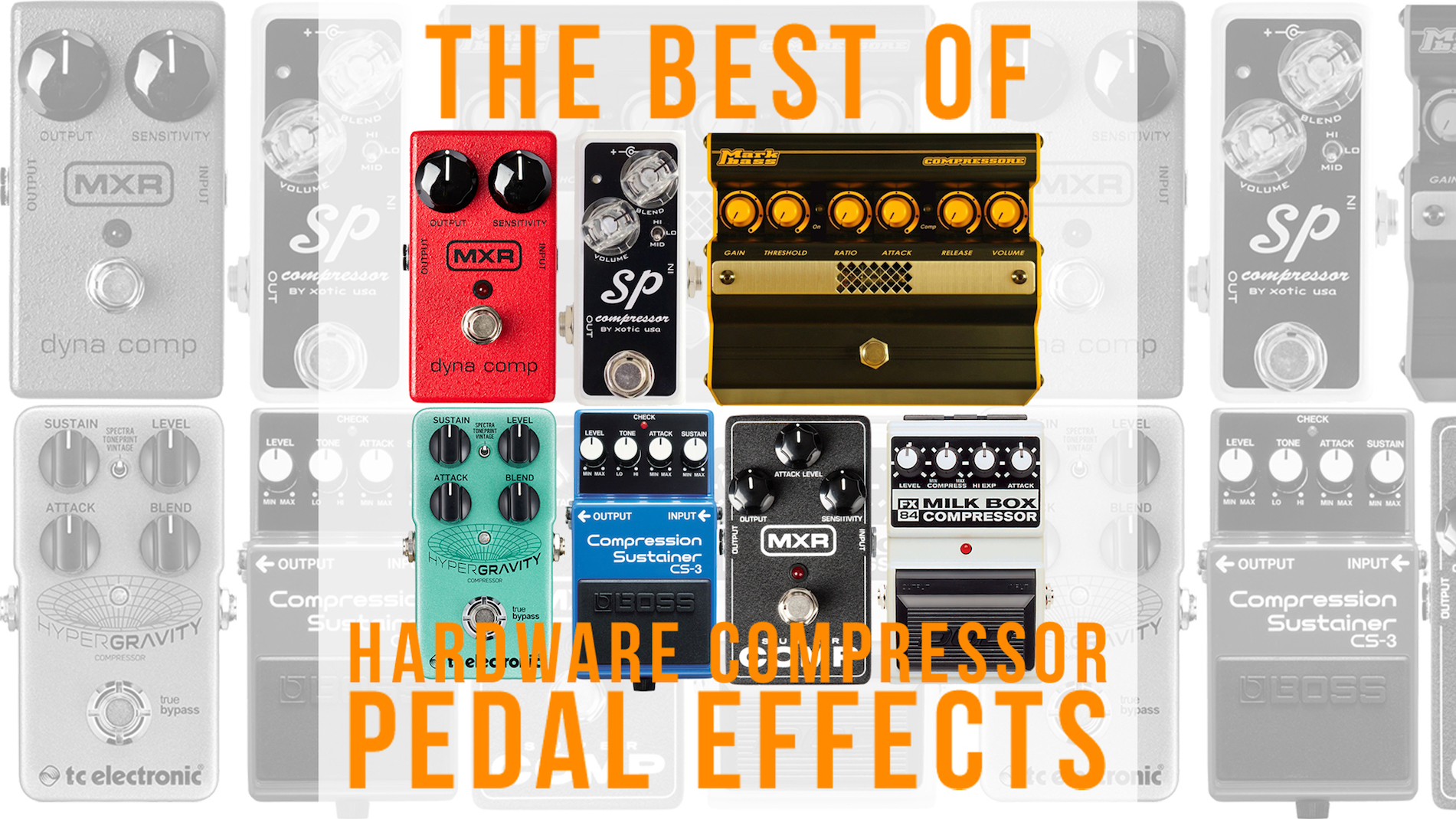Compressor. Perhaps one of the most hard to understand piece of gear. Especially since it’s result is not instantly audible as other effects. But in short, a compressor is a piece of equipment that controls the dynamic range of a signal feeds into it. It suppresses the louder parts to a specific ratio so the difference between the louder and the softer parts is minimized. The result is tighter signal, uniformed in level, and also increased sustain for longer duration. Some also used compressors to get distinct characteristics, fatten tone, or add impact to percussive sounds.
The classic: MXR Dyna Comp
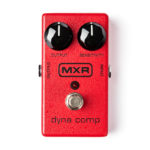 The one who started it all. Available since the 1970s with only two simple knobs. Sensitivity and Output. Sensitivity controls the amount of compression smoothly, so the user doesn’t have to meddle around with more parameters like on a full-sized compressor, while Output makes up for the level after the compression. The Dyna Comp is available in four version: the standard version, the ‘vintage correct spec’ with scripted fonts, the small-sized ‘mini’ version, and the modified one named Super Comp which added an Attack knob.
The one who started it all. Available since the 1970s with only two simple knobs. Sensitivity and Output. Sensitivity controls the amount of compression smoothly, so the user doesn’t have to meddle around with more parameters like on a full-sized compressor, while Output makes up for the level after the compression. The Dyna Comp is available in four version: the standard version, the ‘vintage correct spec’ with scripted fonts, the small-sized ‘mini’ version, and the modified one named Super Comp which added an Attack knob.
The modern: Xotic SP Compressor
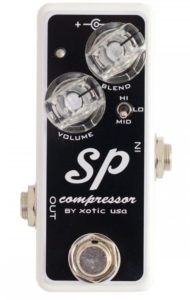 On the outside, it looks just similar to the Dyna comp mini. It has a three-position toggle for the strength of the compression, a Blend knob that mixes the original sound with the compressed signal, and an Output knob. But, inside the casing, it also have four dip-switches that controls attack, release, hi-cut rolloff, and a pad to reduce the input level, in case it was fed with high output instruments.
On the outside, it looks just similar to the Dyna comp mini. It has a three-position toggle for the strength of the compression, a Blend knob that mixes the original sound with the compressed signal, and an Output knob. But, inside the casing, it also have four dip-switches that controls attack, release, hi-cut rolloff, and a pad to reduce the input level, in case it was fed with high output instruments.
The commoner: Boss CS-3
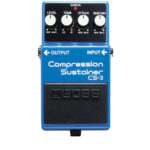 The most often seen on a pedalboard. This one lets the user has more controls to the effect with separate Attack and Release knob, a Tone knob to shape the sound after the compression and an Output knob. It compresses louder signals and boosts softer ones for a smooth sustaining sound, hence the name “Compressor/Sustainer’. And just like other boss pedals, it’s built like a tank.
The most often seen on a pedalboard. This one lets the user has more controls to the effect with separate Attack and Release knob, a Tone knob to shape the sound after the compression and an Output knob. It compresses louder signals and boosts softer ones for a smooth sustaining sound, hence the name “Compressor/Sustainer’. And just like other boss pedals, it’s built like a tank.
The missing link: DOD Milk Box
![]() This one is discontinued, but still pops around on places like eBay, Reverb, or Forum classified sections. The Milk Box is unique because there’s nothing quite like it. The more you compress the signal, the more it expands the higher frequencies. It was available in two graphics: the one with block font with regular parameter names, and the cow-spotted version with confusing parameter names which are: Quartz (output level), Cream (compress), Pasteurization (Hi-freq expander), and Spill (attack)
This one is discontinued, but still pops around on places like eBay, Reverb, or Forum classified sections. The Milk Box is unique because there’s nothing quite like it. The more you compress the signal, the more it expands the higher frequencies. It was available in two graphics: the one with block font with regular parameter names, and the cow-spotted version with confusing parameter names which are: Quartz (output level), Cream (compress), Pasteurization (Hi-freq expander), and Spill (attack)
The hi-tech: TC Electronic Hypergravity
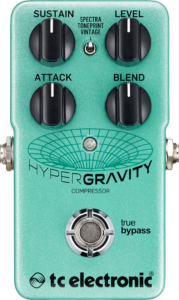 This one brought from the tech giant TC Electronic. A multiband compressor equipped with four knobs and a toggle to switch between the Toneprint setting and two other compressor characteristics. With Toneprint technology, users are able to download settings for this pedal (and other Toneprint-enabled TC pedals). Users also gain access to full parameters via the free Toneprint App on smartphones, or the Toneprint Editor from their computers.
This one brought from the tech giant TC Electronic. A multiband compressor equipped with four knobs and a toggle to switch between the Toneprint setting and two other compressor characteristics. With Toneprint technology, users are able to download settings for this pedal (and other Toneprint-enabled TC pedals). Users also gain access to full parameters via the free Toneprint App on smartphones, or the Toneprint Editor from their computers.
The vintage modified: MXR M87/M76
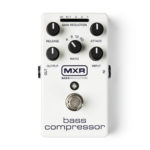
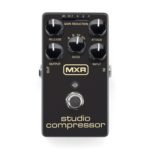 Developed based on the legendary Urei 1176 compressor. It has complete parameter on a standard sized MXR pedal. Input level, Output level, Attack, Release, and Ratio. It’s also equipped with a bright and convenient gain reduction meter to see how much compression applied.
Developed based on the legendary Urei 1176 compressor. It has complete parameter on a standard sized MXR pedal. Input level, Output level, Attack, Release, and Ratio. It’s also equipped with a bright and convenient gain reduction meter to see how much compression applied.
*note: The M76 Studio Compressor is more of the same as M87 Bass Compressor. It was just given a different name and housing to appeal non-bassists.
The tube guardian: Markbass Compressore/DV Mark Compressore
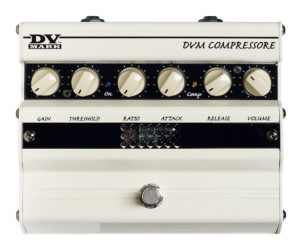 The only one equipped with tube, and housed on a bulky metal case. It features all the controls usually found on studio gears. Thanks to independent Threshold and Gain control, t’s capable to handle any kind of level you feed without distorting. Although Markbass is known as a bass-guitar company, this pedal can also be used for electric guitars and also other acoustic or electric instruments
The only one equipped with tube, and housed on a bulky metal case. It features all the controls usually found on studio gears. Thanks to independent Threshold and Gain control, t’s capable to handle any kind of level you feed without distorting. Although Markbass is known as a bass-guitar company, this pedal can also be used for electric guitars and also other acoustic or electric instruments
*note: The Markbass Compressore is exactly the same as DV Mark Compressore.
BONUS:
 The jack of all trades: Empirical Labs Distressor
The jack of all trades: Empirical Labs Distressor
For users who demand top of the line equipment, for every application they need, this is the real thing. Probably one of the best selling compressor available. This rack unit incorporates many aspects and characteristics of other well-known compressors along with distinct and interesting features such as harmonic distortion mode and ‘Nuke’ setting, a hard brickwall limiting capability.


